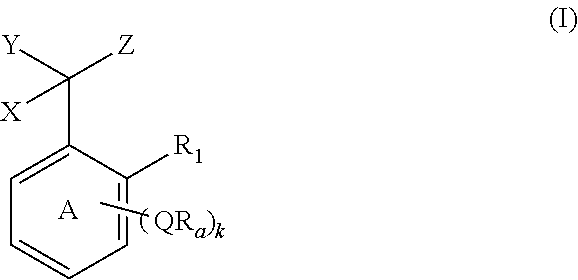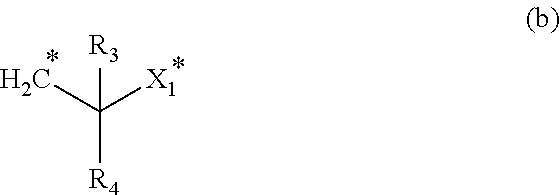Branched chain-containing aromatic compound
a compound and aromatic technology, applied in the field of aromatic compounds, can solve the problems of difficult tracing of reaction and analysis of reaction products supported by carriers, inability to be completely industrially universal, and insoluble or poorly soluble reagents, and achieve the effect of improving liquid separation operability and being easy to soluble in isopropyl aceta
- Summary
- Abstract
- Description
- Claims
- Application Information
AI Technical Summary
Benefits of technology
Problems solved by technology
Method used
Image
Examples
reference example 1
Synthesis of 2,3-dihydrophytol
[0200]
[0201]Phytol (10.00 g, 33.7 mmol) was dissolved in methanol, Pt / C (2%, 1.00 g) was suspended therein and the suspension was stirred overnight under a hydrogen atmosphere. After completion of the reaction, the suspension was filtered to remove Pt / C, and the filtrate was concentrated to give 2,3-dihydrophytol. This was used for the next reaction without purification.
[0202]1H-NMR (300 MHz): δ 0.80-0.93 (15H, m, Me), 0.98-1.70 (24H, br, m, Me2CH—[C3H6—CHMe]3—CH2CH2—OH), 3.62-3.75 (2H, —CH2—OH).
reference example 2
Synthesis of 2,3-dihydrophytyl bromide
[0203]
[0204]2,3-Dihydrophytol (33.7 mmol) was suspended in 48% hydrobromic acid (100 ml), concentrated sulfuric acid (0.17 ml) was added dropwise and the mixture was stirred at 100° C. overnight. The reaction mixture was cooled to room temperature, extracted with hexane (200 ml), and washed twice with 5% aqueous sodium hydrogen carbonate solution (70 ml) and once with 20% brine (70 ml). The organic layer was dried over sodium sulfate, and the solvent of the filtrate was evaporated. The obtained residue was purified by silica gel column chromatography (short column, hexane alone) to give 2,3-dihydrophytyl bromide (2,3-dihydrophytyl group is sometimes to be referred to as “Phy” hereunder) (10.41 g, 28.8 mmol, 85% vs. phytol).
[0205]1H-NMR (300 MHz): δ 0.79-0.92 (15H, m, Me), 0.95-1.95 (24H, br, m, Me2CH-[C3H6—CHMe]3—CH2CH2—Br), 3.35-3.52 (2H, —CH2—Br).
reference example 3
Synthesis of 3,7,11-trimethyldodecan-1-ol
[0206]
[0207]Farnesol (3.00 g, 13.5 mmol) was dissolved in MeOH (30 ml), Pt / C (2%, 0.30 g) was suspended therein and the suspension was stirred overnight under a hydrogen atmosphere. After completion of the reaction, Pt / C was removed by filtration, and the filtrate was concentrated to give 3,7,11-trimethyldodecan-1-ol. This was used for the next reaction without purification.
[0208]1H-NMR (300 MHz): δ 1.09-1.43 (m, 24H), 1.48-1.66 (m, 5H), 3.63-3.70 (m, 2H).
PUM
| Property | Measurement | Unit |
|---|---|---|
| Temperature | aaaaa | aaaaa |
| Percent by mass | aaaaa | aaaaa |
| Percent by mass | aaaaa | aaaaa |
Abstract
Description
Claims
Application Information
 Login to View More
Login to View More - R&D
- Intellectual Property
- Life Sciences
- Materials
- Tech Scout
- Unparalleled Data Quality
- Higher Quality Content
- 60% Fewer Hallucinations
Browse by: Latest US Patents, China's latest patents, Technical Efficacy Thesaurus, Application Domain, Technology Topic, Popular Technical Reports.
© 2025 PatSnap. All rights reserved.Legal|Privacy policy|Modern Slavery Act Transparency Statement|Sitemap|About US| Contact US: help@patsnap.com



